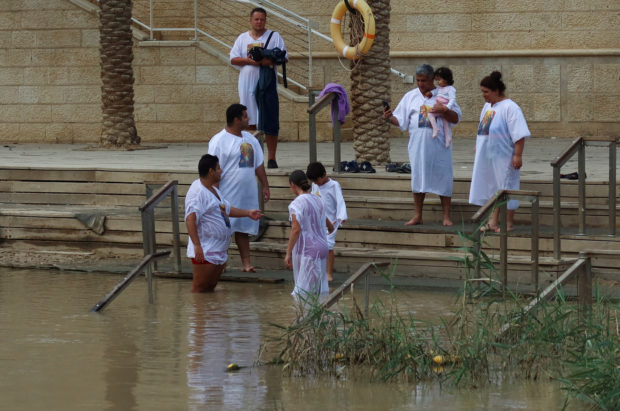
People dip themselves in Jordan River at the Qasr el-Yahud site, near Jericho, in the Israeli-occupied West Bank, as pictured from the Jordan Valley, Jordan December 6, 2022. REUTERS FILE PHOTO
BETHANY BEYOND THE JORDAN, Jordan — For centuries thousands of pilgrims a year have made the journey to Bethany Beyond The Jordan, a site on the east bank of the Jordan River which Christians believe to be the exact spot where Jesus was baptized.
This number could swell to one million visitors a year if a proposed phased six-year estimated $300 million project for a ‘tourist city’ adjacent to what is a designated UNESCO World Heritage site goes ahead.
Among those who gathered at the river bank last week were Jordan’s King Abdullah and Lebanon’s Maronite Patriarch Bechara Boutros Al-Rai, who joined architects, museum curators and investors to hear about the proposal from its organizers.
Organizers hope that with souvenir shops and walking trails, boutique hotels and botanical gardens, the site – which lies outside the formal boundary of the baptism location – will eventually attract five times as many annual visitors than the current 200,000, and will to help preserve the region’s dwindling Christian presence.
The project still needs funding, however, and planners are presenting their plans to Christian leaders from all denominations from the Middle East and beyond in the hope it will help draw donors, investors and contributing churches.
King Abdullah has been praised by Christian leaders for fostering religious harmony in Jordan’s majority Muslim population by offering land to churches and pilgrimage centers.
“This helps Christians in the Middle East to preserve their presence and their credo,” Al-Rai, who is Lebanon’s leading Christian cleric, told Reuters after a ceremony attended by the monarch that unveiled the masterplan for the project.
Pristine
Bethany Upon The Jordan, which lies around 50 km (31 miles)west of Amman, is mentioned in the Gospel of John as the place where John the Baptist baptised Jesus.
Extensive excavations since the mid-1990s have unearthed ruins of churches, baptismal pools and caves that show it was a Christian pilgrimage site as early as the fourth century.
In recent years, the unregulated construction of huge edifices and churches by competing churches has altered the once-untouched landscape.
Planners say their aim is to preserve the site and its ancient history.
“We are talking about rustic stones and pebbles in architectural designs that preserve the place’s pristine nature and ensure that the sanctity and spirituality that existed 2,000 years ago are not trampled on by any development,” Kamel Mahadin the 67-year old architect behind the designs who briefed the monarch on the masterplan.
“We are not talking about a high-tech landscape,” he said.
Mahadin had earlier guided clerics and possible funders through the surrounding hilly plains, leaving some of them awe-struck.
“The extraordinary resonance of this landscape… and the significance of that event in human history shakes you to the core,” said John Booth, chairman of Britain’s National Gallery, who attended the launch.
Samir Murad, a former minister and businessman who chairs the non-profit independent foundation set up by law that oversees the project, said no state funds would be spent and no land sold to foreign investors.
His pledges are meant to allay fears of profiteering and over-commercialization, though some were still skeptical.
Jordanian Baptist Evangelical researcher Philiph Madanat says strict guidelines should be put in place to guarantee transparency and prevent the abuse of funds, given it would be the kingdom’s first money-generating Christian site.
“This is an attempt to usurp religious spirit. It is unprecedented to have such a Christian holy site used for this purpose in Jordan,” Madanat added.
The over-development of the future site would tamper with a wild habitat that has been largely left intact from biblical times.
Camels and sheep graze in a landscape dotted with tamarisk and persimmon trees in scenes unchanged from 2,000 years ago, and some clerics say that is how it should stay, insisting on the site’s sanctity.
But for other local church leaders and Jordan as a whole, pilgrims from across the global would bring much-needed revenues in a country where tourism forms 20% of a $50 billion economy.
The World Bank says resurging tourism post-COVID would help boost Jordan’s economic recovery from a slump in recent years.
“It will lead to prosperity when tourists who come and buy souvenirs and get services help the local community and the country at large,” said Father Ibrahim Dabbour, the general secretary of the Assembly of Christian leaders of Jordan that represents all denominations.
RELATED STORIES
Work dries up for Jordan’s donkeys as coronavirus cripples tourism
WATCH: First travelers cross from Jordan to Syria as key border crossing reopens

